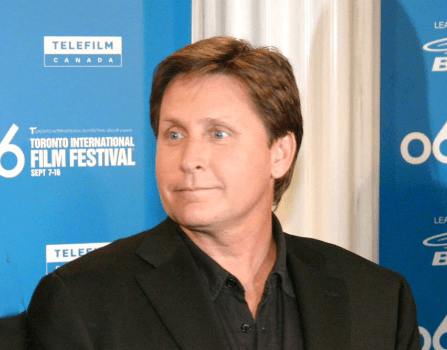Emilio Estevez has subtly carved out a career for himself in recent decades, setting him apart from the conventional story of child-of-Hollywood celebrity. Instead of striving for tabloid fame or headlines, he has built a diverse profession that is incredibly resilient. With an estimated net worth of $18 million, his financial story is told through strategic changes, independent creativity, and a grounded way of living rather than through huge payouts.

Estevez was already well-known by the middle of the 1980s. He became a prominent part of the so-called “Brat Pack” because of his captivating on-screen persona in St. Elmo’s Fire, The Outsiders, and The Breakfast Club. Together, these actors—most notably Rob Lowe, Molly Ringwald, and Andrew McCarthy—frequently made appearances, capturing the anxiety and charm of a generation. Estevez, however, progressively changed his concentration behind the camera—a move that was both calculated and intensely personal—while others of his friends flamed out or disappeared completely.
Emilio Estevez – Personal & Professional Snapshot
| Attribute | Information |
|---|---|
| Full Name | Emilio Estevez |
| Date of Birth | May 12, 1962 |
| Age | 63 |
| Birthplace | Staten Island, New York, United States |
| Nationality | American |
| Profession | Actor, Director, Writer, Producer |
| Estimated Net Worth | $18 million (2025) |
| Major Credits | The Breakfast Club, The Mighty Ducks, St. Elmo’s Fire |
| Business Ventures | Estevez Sheen Productions, Malibu Vineyard |
| Family | Son of Martin Sheen, Brother of Charlie Sheen |
| Directorial Works | Bobby, The Way, The Public, TV episodes of Cold Case, CSI: NY |
| Real Estate Move | Malibu property sold for $6.35 million (originally purchased for $2.2M) |
| Source Link | Celebrity Net Worth |
Through directing movies like Bobby, The War at Home, and Wisdom, Estevez started to use a different sort of power. His aim to portray emotionally complex stories was evident in Bobby, in particular, where his societal critique was remarkably clear. Even though they didn’t make it to the top of the box office rankings, these efforts cemented his reputation among festivalgoers and critics and made a significant contribution to his creative legacy. His approach was extremely avant-garde, particularly in The Way, a moving pilgrimage movie starring his father Martin Sheen, which showed an artist more concerned with meaning than praise.
Estevez also become a frequent director on network television through strategic alliances. He demonstrated his exceptional versatility across genres by directing episodes of Cold Case, CSI: NY, Criminal Minds, and even his brother Charlie’s sitcom Two and a Half Men. In addition to helping him hone his technical abilities, this move to serial directing gave him a steady source of money as acting offers started to decline.
His investing decisions outside of Hollywood have been exceptionally astute. Estevez paid $2.2 million for a property in Malibu at the beginning of the new millennium. He sold it for a healthy $6.35 million by December 2016, which was a very profitable move that demonstrated his knowledge of California’s cycles in luxury real estate. His strategy was incredibly dependable—patient, measured, and full of foresight—in contrast to the erratic financial trajectories of other former adolescent icons.
Estevez’s vineyard is one of the more intriguing parts of his tale. His artisanal wine production in Malibu is far from being just another vanity endeavor; rather, it gives his business portfolio a sense of legitimacy. Estevez’s vineyard highlights how Hollywood creatives are increasingly lured to lifestyle branding as a secondary source of income, much like Cameron Diaz’s Avaline wine or Brad Pitt’s Château Miraval. For him, it’s also a peaceful spot where terroir and taste, rather than narrative and camera angles, tell the story.
Emilio Estevez has been occasionally but significantly sighted in public over the last ten years. Fans recently had a rare moment of nostalgia as he attended The Breakfast Club’s 40th anniversary reunion. He said, “It just felt like it was time,” in reference to his decision to finally attend such an event. Fans appreciate his distance just as much as they like his work, and that straightforward statement, given with his usual humility, served as a reminder. He only comes back when it’s necessary; he’s not wanting to stay in the spotlight.
When it comes to family dynamics, Estevez and his brother, Charlie Sheen, are very different. At his height, Charlie made millions of dollars per episode, but his financial difficulties and scandals eroded a large portion of that wealth. The perils that come with celebrity have been greatly diminished by Emilio’s more stable, low-key career. His choice to stick with his given name instead of taking on the Sheen nickname was highly symbolic, highlighting his independence and will to achieve his goals on his own terms.
Early-stage filmmakers looking for a guide to artistic survival might learn a lot from Emilio Estevez’s career. He accepted a variety of creative jobs, stayed away from overexposure, and branched out into business endeavors that matched his interests. He demonstrated that you don’t have to pursue the biggest salary in order to have a fulfilling and long-lasting job, whether you’re making movies or selling expensive real estate.
Estevez went from teenage heartthrob to a seasoned performer with a lasting impact by utilizing both his artistic abilities and business savvy. His decisions regularly demonstrate a preference for long-term goals over immediate gains—a trait remarkably reminiscent of directors such as Ron Howard, who similarly made the shift from actor to industry veteran with amazing elegance.
Estevez will continue to profit from Hollywood’s celebration of nostalgia-driven revivals. His intellectual property is gaining value once more as titles like The Mighty Ducks are making a comeback to streaming services and Gen X viewers are ready to reconnect. He continues to be a part of the cultural environment despite not appearing regularly, especially as more streaming behemoths try to adapt 80s entertainment for contemporary audiences.
